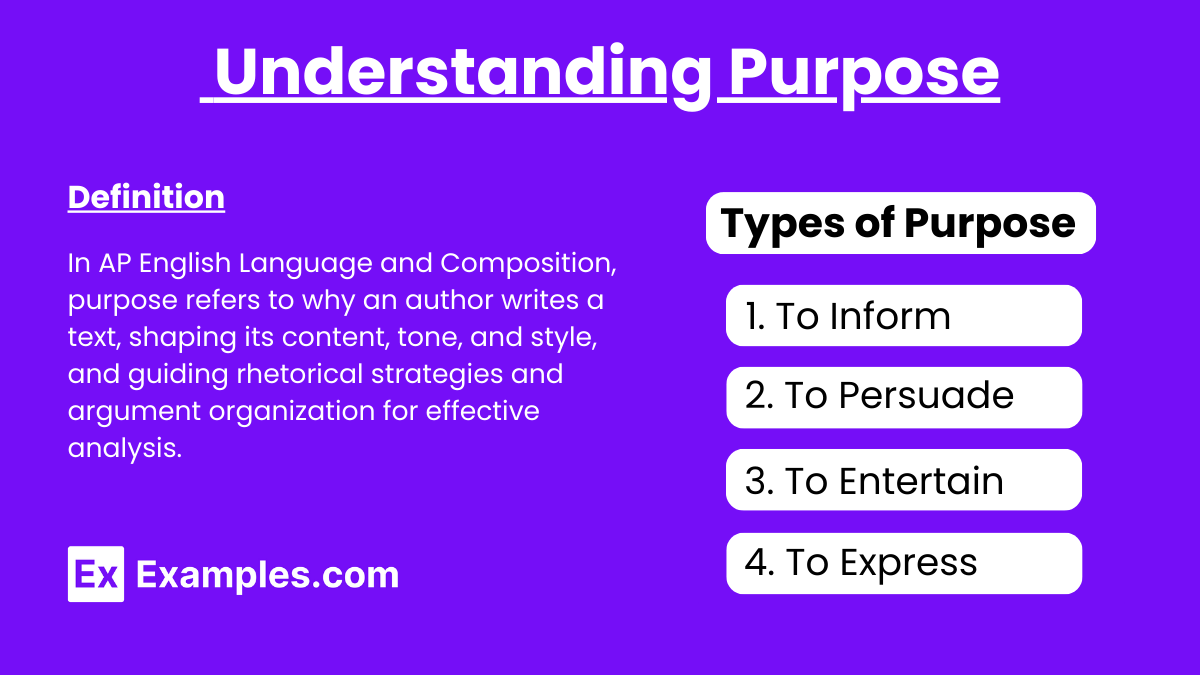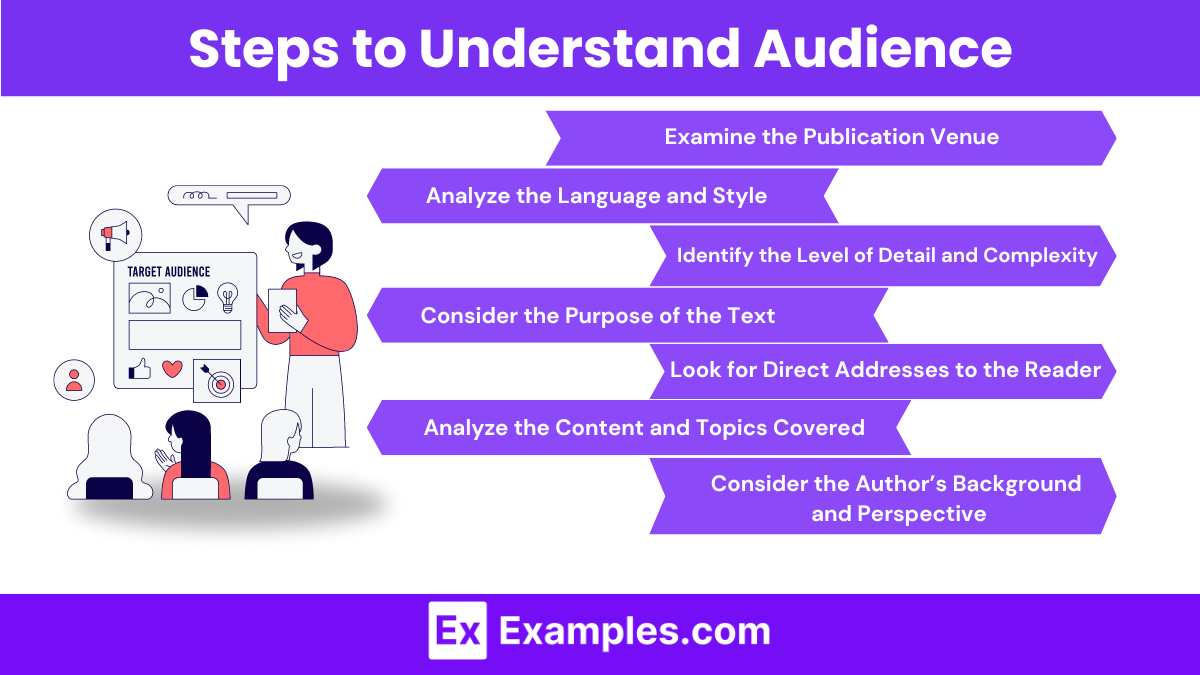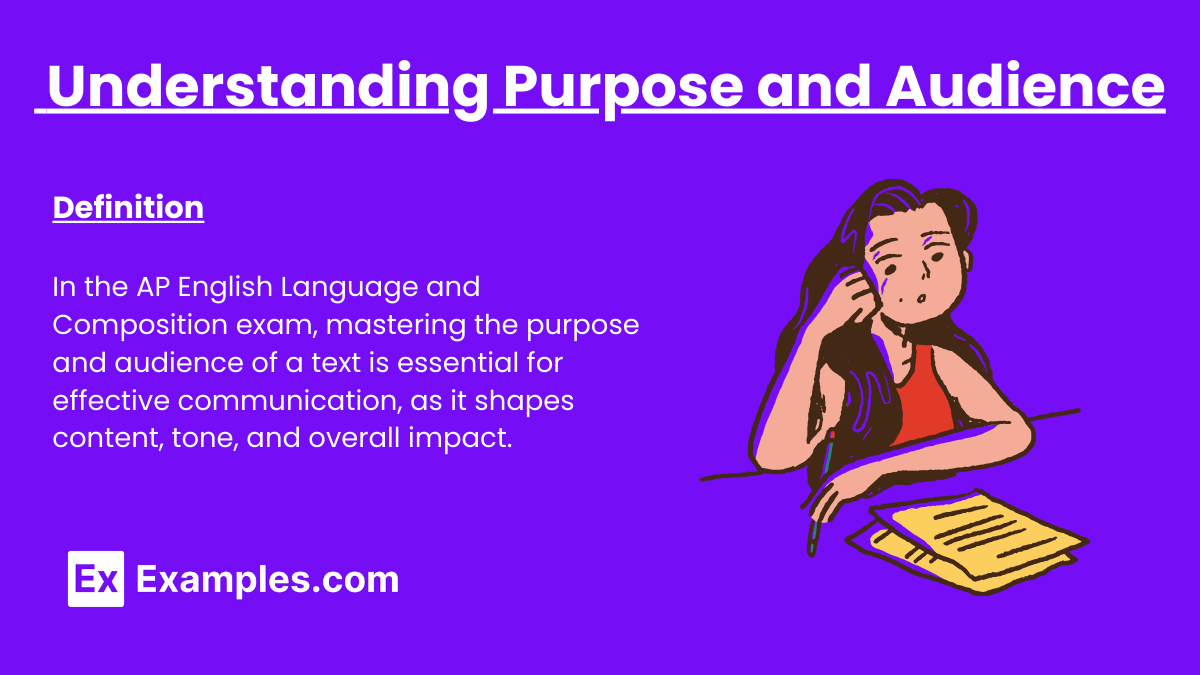In the AP English Language and Composition exam, one of the key skills you must master is understanding the purpose and audience of a text. This skill is not just crucial for the exam but also for effective communication in general. The purpose of a text is the reason behind the author’s decision to write it, which can range from informing and persuading to entertaining and reflecting. The audience, on the other hand, is the specific group of readers the author aims to reach. Recognizing these elements is essential because they shape how the content is presented, the tone used, and the overall impact of the writing.
Understanding Purpose

Purpose in AP English Language and Composition refers to the reason an author writes a text. It shapes the content, tone, and style of the writing, guiding the selection of rhetorical strategies and the structuring of arguments. Recognizing the purpose of a text is crucial for effective analysis and for crafting your own essays. Purpose influences the selection of rhetorical strategies and the organization of arguments, guiding the reader’s understanding and engagement with the text.
Types of Purpose
1. To Inform
- Definition: The primary goal is to provide information or explain a topic clearly and accurately.
- Characteristics:
- Objective tone
- Clear, concise explanations
- Use of facts, statistics, and evidence
- Logical organization
- Examples:
- Textbooks
- News articles
- Scientific reports
- Rhetorical Strategies:
- Use of data and research
- Explanatory or descriptive language
- Comparisons and analogies to clarify concepts
2. To Persuade
- Definition: The author aims to convince the audience to adopt a particular viewpoint or take specific action.
- Characteristics:
- Emotive language
- Strong, clear thesis statement
- Use of rhetorical appeals (ethos, pathos, logos)
- Evidence and examples supporting the argument
- Examples:
- Opinion pieces
- Advertisements
- Political speeches
- Rhetorical Strategies:
- Appeals to credibility (ethos)
- Emotional appeals (pathos)
- Logical arguments (logos)
- Use of rhetorical questions and persuasive techniques
3. To Entertain
- Definition: The author’s goal is to engage and amuse the audience, often through storytelling.
- Characteristics:
- Examples:
- Novels
- Short stories
- Plays
- Rhetorical Strategies:
- Descriptive and figurative language
- Narrative techniques like foreshadowing and flashback
- Dialogue and character development
4. To Express
- Definition: The author conveys personal thoughts, feelings, or experiences, often reflecting on personal insights.
- Characteristics:
- Subjective tone
- Descriptive and emotive language
- First-person perspective
- Introspection and personal reflections
- Examples:
- Diaries
- Memoirs
- Personal essays
- Rhetorical Strategies:
- Use of vivid imagery and sensory details
- Personal anecdotes
- Reflective and introspective language
How to analyzing Purpose in Texts
- Examine the Title and Introduction: Look for clues about the author’s intent.
- Analyze the Content: Determine whether the text aims to inform, persuade, entertain, or express.
- Identify Rhetorical Strategies: Look for techniques the author uses to achieve their purpose.
- Consider the Audience: Understanding who the text is directed at can help clarify the purpose.
Examples for Analyzing Purpose from Text
Example 1: Informative Text
Text: Excerpt from a Scientific Article on Climate Change
Title: “The Impact of Greenhouse Gases on Global Warming”
Excerpt: “Greenhouse gases, such as carbon dioxide and methane, trap heat in the Earth’s atmosphere, leading to an increase in global temperatures. This process, known as the greenhouse effect, has been significantly intensified by human activities, particularly the burning of fossil fuels and deforestation. Scientists predict that if current trends continue, we could see a rise in global temperatures of up to 4°C by the end of the century, resulting in severe weather patterns, rising sea levels, and impacts on biodiversity.”
Analysis:
- Purpose: To inform
- Content: Provides factual information about greenhouse gases and their impact on global warming.
- Evidence: Uses scientific data and predictions from experts.
- Tone and Language: Objective and informative.
- Rhetorical Strategies:
- Logos: Relies on logical explanations and data.
- Ethos: Establishes credibility by referencing scientific research.
- Audience: General public, students, and individuals interested in environmental science.
Example 2: Persuasive Text
Text: Excerpt from an Editorial on Renewable Energy
Title: “Why We Must Transition to Renewable Energy Sources Now”
Excerpt: “As fossil fuel reserves dwindle and the effects of climate change become more pronounced, the urgency to switch to renewable energy sources has never been greater. Renewable energy not only reduces greenhouse gas emissions but also provides sustainable economic growth and job creation. It is imperative that governments and industries invest in solar, wind, and hydroelectric power to secure a healthier and more prosperous future for our planet.”
Analysis:
- Purpose: To persuade
- Content: Argues for the transition to renewable energy sources.
- Evidence: Highlights environmental benefits and economic advantages.
- Tone and Language: Urgent and emotive.
- Rhetorical Strategies:
- Pathos: Appeals to the audience’s emotions by emphasizing the urgency and positive impacts.
- Ethos: Establishes credibility by discussing the broader impacts on society and the environment.
- Logos: Uses logical arguments and evidence to support the claim.
- Audience: Policymakers, environmental advocates, and the general public.
Example 3: Entertaining Text
Text: Excerpt from a Short Story
Title: “The Enchanted Forest”
Excerpt: “Deep within the heart of the Enchanted Forest, where the trees whispered secrets and the streams sang lullabies, lived a mischievous fairy named Elara. Every night, she would sprinkle her magic dust over the forest, causing the flowers to glow and the animals to dance. But one day, a curious human stumbled upon the forest, setting off a chain of events that would change Elara’s life forever.”
Analysis:
- Purpose: To entertain
- Content: Tells a whimsical story about a fairy in an enchanted forest.
- Evidence: Uses imaginative and descriptive language to create a vivid picture.
- Tone and Language: Playful and magical.
- Rhetorical Strategies:
- Imagery: Vivid descriptions of the forest and characters.
- Narrative Techniques: Uses storytelling elements such as plot, character development, and suspense.
- Audience: Children, fantasy enthusiasts, and general readers looking for entertainment.
Example 4: Expressive Text
Text: Excerpt from a Personal Essay
Title: “Reflections on My Journey”
Excerpt: “Growing up in a small town, I always felt a sense of yearning for something more. My childhood was filled with moments of quiet introspection and dreams of far-off places. It wasn’t until I left for college that I began to understand the depth of my ambitions. Each new experience, every challenge faced, became a stepping stone toward self-discovery. Now, as I look back, I see how each moment, no matter how insignificant it seemed at the time, contributed to the person I am today.”
Analysis:
- Purpose: To express
- Content: Reflects on personal experiences and growth.
- Evidence: Uses personal anecdotes and introspective thoughts.
- Tone and Language: Reflective and personal.
- Rhetorical Strategies:
- Pathos: Connects with the reader on an emotional level through personal stories.
- Imagery: Uses descriptive language to evoke vivid memories and emotions.
- Audience: General readers, individuals interested in personal growth and introspection
Understanding Audience
In AP English Language and Composition, understanding the concept of audience is essential. The audience refers to the group of readers or viewers that the author intends to reach. Knowing who the audience is helps shape the content, tone, and style of a text. It influences the choice of language, the complexity of the information, and the type of examples and evidence used. For students, grasping the idea of audience is crucial not only for analyzing texts but also for writing effectively. By identifying the target audience, you can tailor your message to ensure it resonates and achieves its intended effect, enhancing both your analytical and writing skills for the AP exam and beyond.
Steps to Understand Audience

1. Examine the Publication Venue
- Where is the text published?
- Academic journals, newspapers, websites, and social media platforms each have different target audiences.
- Example: A research article in a medical journal is aimed at healthcare professionals, while a blog post on a popular website may target a general audience.
2. Analyze the Language and Style
- What type of language is used?
- Formal, technical language suggests a specialized audience, while informal, conversational language indicates a general audience.
- Example: Technical jargon and complex sentences indicate an audience with specific knowledge in the field, such as scientists or experts.
3. Identify the Level of Detail and Complexity
- How detailed and complex is the information?
- High levels of detail and complexity suggest an audience that is familiar with the subject.
- Example: Detailed explanations and extensive use of technical terms in a text about computer programming suggest it is intended for programmers.
4. Consider the Purpose of the Text
- What is the text’s purpose?
- The purpose (to inform, persuade, entertain, or express) often influences the intended audience.
- Example: A persuasive essay advocating for policy change is likely targeting policymakers, activists, or voters.
5. Look for Direct Addresses to the Reader
- Does the author speak directly to the reader?
- Direct addresses can provide clues about the audience.
- Example: Phrases like “As parents, you should…” indicate that the text is aimed at parents.
6. Analyze the Content and Topics Covered
- What topics are covered and how are they presented?
- Topics and their presentation can give insights into the audience’s interests and needs.
- Example: An article discussing retirement planning with tips on managing savings is likely aimed at older adults or those nearing retirement age.
7. Consider the Author’s Background and Perspective
- Who is the author and what is their perspective?
- The author’s background and perspective can influence who they write for.
- Example: A text written by a medical doctor discussing health tips is likely intended for patients or general readers seeking health advice.
Example for Analyzing the Audience in a Text
Text: An excerpt from a health and wellness article in a lifestyle magazine
Title: “10 Simple Ways to Improve Your Mental Health”
Excerpt: “In today’s fast-paced world, taking care of your mental health is more important than ever. From practicing mindfulness to staying physically active, there are simple steps you can take to enhance your well-being. Incorporate these practices into your daily routine to feel more balanced and happier.”
Audience: The audience for this text is likely the general public, particularly individuals interested in health and wellness. This includes people who are looking for simple, practical advice to improve their mental health without needing specialized knowledge or expertise. The article is written in an accessible, conversational style that appeals to a broad range of readers, making it suitable for anyone looking to enhance their well-being through easy-to-implement practices.


